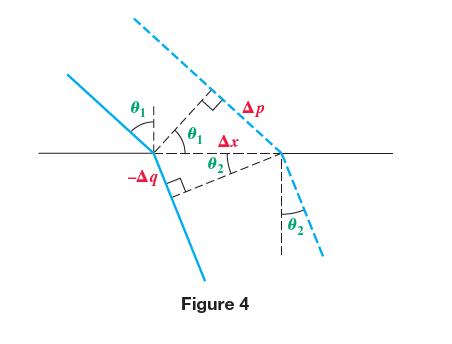1. In Figure 4, we drew the two rays coming from point A as if they were...
Question:
1. In Figure 4, we drew the two rays coming from point A as if they were nearly parallel. Why can’t they be parallel? If they were parallel, how would you prove that the two angles labeled 01 are equal? How could you make the rays more nearly parallel?
2. In Figure 4, we claim that the segment labeled Δp is the change in the length of the ray from point A. Is it? How could you improve the approximation?
3. If you wear glasses, you’ve probably been offered the choice between glass and “high-index plastic” for your lenses. The typical high-index plastic lens has an index of refraction of 1.6, which means that the ratio (speed of light in air)/(speed of light in plastic) is equal to 1.6. What percent of the speed of light in air is the speed of light in 1.6-index plastic?
4. Without doing the calculation, describe the cheapest route for the road between A and B in the case where swamp construction is 100 times as expensive as construction over land.
5. In the road construction example, what would change in the equation for x if construction over land was actually more expensive than construction over the swamp? Find the best x for the case where dry-land construction is twice as expensive as swamp construction, and show that the corresponding route lies to the west of the straight-line route.
6. A light ray that reaches you when you look at a sunset is bent by the same process of refraction that Snell’s law describes. The higher density and higher water content of the air close to Earth cause light to travel more slowly closer to Earth, so as it moves through the atmosphere the light ray is bent down toward Earth. Rather than happening all at once at a sharp interface between one medium and another, this atmospheric refraction happens gradually, so the light follows a curved path. Light rays coming at an angle of 90° to the vertical (that is, directly from the horizon) are bent by an angle of about 0.57°. The diameter of the sun’s disk as we see it is about 0.53°. When you see the sun begin to set, where is it actually located?*
Figure 4
Step by Step Answer:






